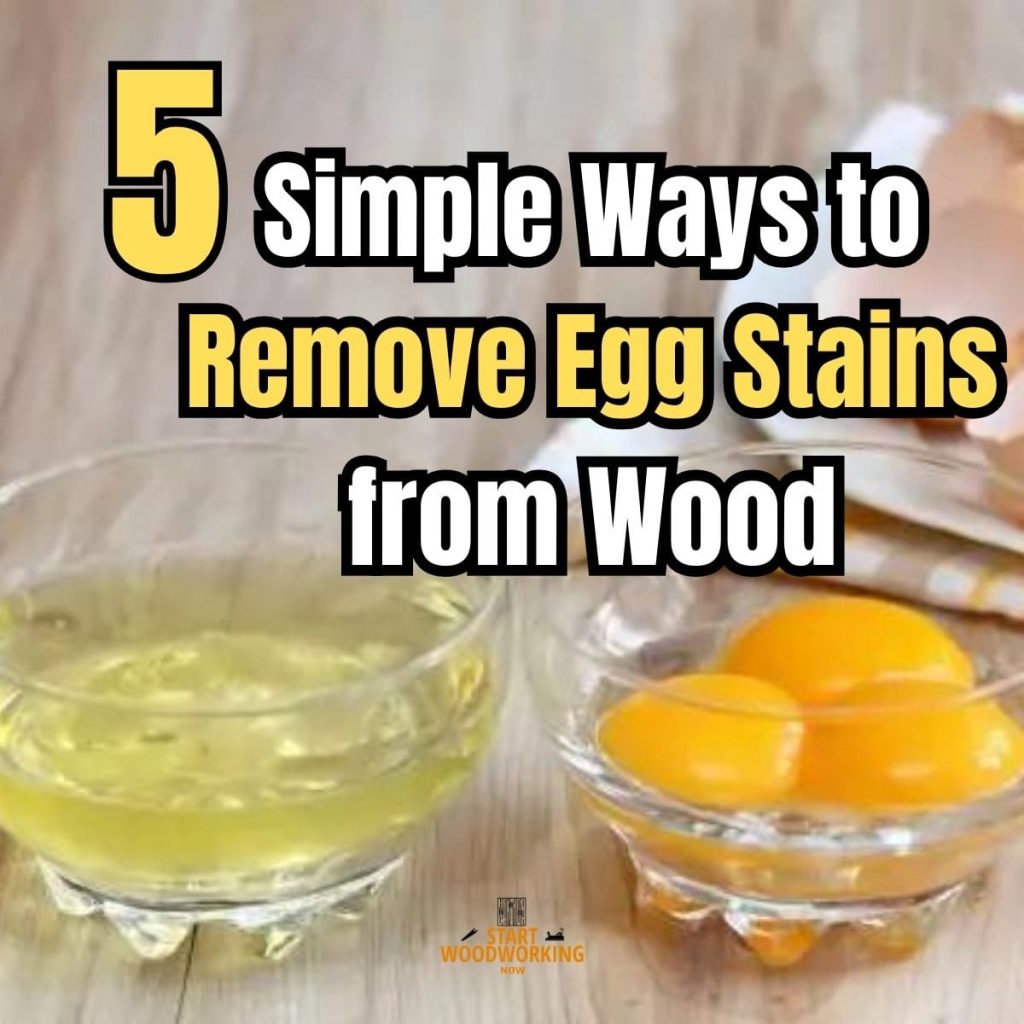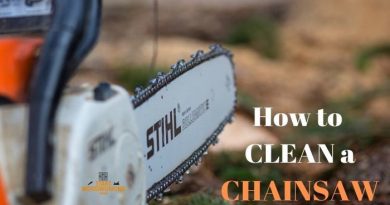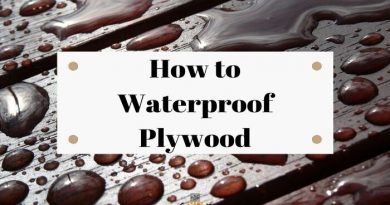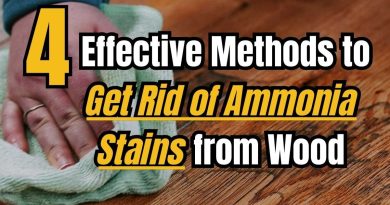5 Effective Methods to Remove Egg Stains from Wood! With Ease!
| Wood Type | Porosity | Finish Type | Preferred Egg Stain Removal Method |
|---|---|---|---|
| Hardwood (e.g., Oak, Maple) | Low to Medium | Varnish, Polyurethane | Sudsing Technique |
| Softwood (e.g., Pine, Cedar) | High | Oil, Wax | Baking Soda Paste |
| Veneer | Low to Medium | Lacquer, Varnish | Sudsing Technique |
| Engineered Wood (e.g., Plywood) | Low (due to coatings) | Laminate, Veneer | Baking Soda Paste / White Vinegar Solution |
Remove Fresh Egg Stain from Wood Surfaces
Method #1. Sudsing Technique
- Crafting the Sudsy Solution: I begin by filling a container with cool water—cool because it’s less likely to cook the egg proteins—and mix in a few drops of mild dish soap or laundry detergent. I whip the solution until it’s full of frothy suds. The detergent’s surfactants will work to break down and lift the egg’s proteins from the wood.
- Applying the Suds: I carefully scoop up the frothy suds with a clean sponge or soft-bristled brush, avoiding the liquid beneath. The key is to use the foam only, as too much water can damage the wood. I gently spread the suds over the fresh egg stain, ensuring that I cover it completely but without soaking the wood.
- Gentle Cleaning: With the suds in place, I softly work them into the stain in a circular motion. The motion and the suds combined help to encapsulate and lift the egg from the wood without the need for harsh scrubbing, which could harm the wood’s finish.
- Rinsing and Drying: Once I’m satisfied that the stain is lifted, I take a clean, damp cloth—wringing it out thoroughly to ensure it’s not too wet—and gently wipe away the suds and any remaining egg residue. It’s important to be gentle to avoid saturating the wood. Immediately after, I dry the area with a soft, absorbent towel to prevent any moisture from lingering, which could damage the wood over time.
Method #2. Baking Soda Paste
- Creating the Baking Soda Paste: I start by mixing baking soda with a small amount of water in a bowl. I aim for a thick, paste-like consistency, similar to toothpaste. This ensures that the baking soda is concentrated enough to tackle the stain without being too runny, which could seep into the wood grain and cause damage.
- Applying the Paste: With a spatula or an old credit card, I spread the paste over the egg stain, completely covering it. I use a tool to apply the paste to avoid pushing the egg further into the wood’s pores with a cloth or sponge.
- Letting It Work: I allow the paste to sit on the stain for about 15 minutes. During this time, the natural abrasiveness of the baking soda works to lift the proteins in the egg from the wood, while the paste absorbs the moisture.
- Gentle Scrubbing and Removal: After the paste has had time to set, I use a soft-bristled brush to gently scrub the area in a circular motion. This helps to break up the egg stain without scratching the wood’s finish. Then, I carefully wipe away the paste with a soft, damp cloth, making sure to remove all the residue.
- Rinsing and Drying: To ensure no baking soda is left behind, which could leave a white residue or potentially damage the wood if it absorbs moisture, I go over the area once more with a clean, damp cloth. Immediately after, I dry the wood thoroughly with a soft towel to prevent any water damage.
Method #3. Cornstarch and Vinegar Paste
- Making the Cornstarch and Vinegar Paste: I combine cornstarch with white vinegar in a small bowl, mixing until I achieve a thick, paste-like consistency. The cornstarch serves as a gentle abrasive and absorbent, while the vinegar’s acidity helps to break down the egg’s proteins.
- Application of the Paste: Using a plastic spatula or the back of a spoon, I carefully spread the paste over the entire egg stain, ensuring that it’s fully covered. I’m cautious to apply it gently to avoid pushing the egg deeper into the wood grain.
- Setting Time: I let the paste sit on the stain for about 10 to 15 minutes. During this time, the vinegar works to dissolve the stain, and the cornstarch absorbs it from the wood surface.
- Scrubbing Off the Stain: After the paste has been set, I use a soft-bristled brush to lightly scrub the area in a circular motion. This helps to lift the egg residue without scratching the wood’s finish.
- Final Cleaning: Once I’m satisfied that the stain has been removed, I wipe the area with a soft, slightly damp cloth to clean off any remaining paste and residue. Then, I immediately follow up with a dry towel to absorb any moisture, preventing potential water damage to the wood.
Remove Dried Egg Stains from the Wood Surfaces
Method #1. Credit Card Scrape and Mineral Spirits
- Scraping the Dried Egg: I take a plastic card, like a credit card or a plastic scraper, which is gentle on the wood finish. I hold the card at an angle and gently scrape away the dried egg. The edge of the card is thin enough to get under the edges of the stain, lifting it from the surface without scratching the wood.
- Applying Mineral Spirits: After removing as much of the dried egg as possible, I dampen a clean, soft cloth with mineral spirits. These spirits are effective at dissolving any remaining egg residue without damaging the wood finish. It’s important to use the cloth sparingly, ensuring it’s damp but not wet to avoid over-saturation, which could harm the wood.
- Wiping the Area: I wipe the area where the egg stain was, using the cloth with mineral spirits. I make sure to work in the direction of the wood grain, which helps to lift any remaining residue and prevents the wood fibers from swelling or lifting.
- Drying the Wood: Finally, I immediately dry the area with a clean, dry cloth to remove any leftover moisture from the mineral spirits. This step is crucial to prevent any potential damage that could be caused by the solvent sitting on the wood for too long.
Method #1. White Vinegar Solution
- Preparing the White Vinegar Solution: I mix equal parts white vinegar and warm water to create a mild acidic solution that can break down the proteins in the dried egg. The warmth of the water helps to dissolve the stain, while the vinegar acts as a natural disinfectant without harming the wood’s finish.
- Applying the Solution: With a soft cloth or sponge, I dip it into the vinegar solution and wring it out so it’s damp, not dripping. Then, I gently blot the dried egg stain. It’s important to dab rather than rub to avoid spreading the stain or pushing it deeper into the wood grain.
- Letting the Solution Work: I allow the vinegar solution to sit on the stain for a few minutes. This gives the acetic acid time to work into the egg stain, softening it for easier removal.
- Wiping Away the Stain: After the solution has had time to penetrate the stain, I use a fresh section of the cloth to gently wipe away the loosened egg residue. If necessary, I repeat the application of the vinegar solution followed by gentle wiping until the stain is fully removed.
- Rinsing and Drying: Once the stain is gone, I rinse the area with a cloth dampened with clean water to remove any vinegar residue, as lingering acidity could potentially damage the wood over time. I finish by drying the wood thoroughly with a clean, soft towel.
Tips to Protect Wood Surfaces from Egg Stains
As a professional woodworker, protecting wood surfaces from egg stains is just as important as knowing how to remove them. Here are some of my best tips for preventing egg stains on wood:
- Seal the Wood: Apply a high-quality sealer or varnish to your wood surfaces. This creates a barrier that can repel liquids and prevent stains from setting in. Make sure to choose a sealant that’s appropriate for the type of wood and the conditions it will be exposed to.
- Use Coasters and Trivets: Always place coasters under glasses and trivets under hot dishes. This simple practice can prevent condensation, spills, and heat from causing damage or creating an environment where egg stains could adhere more easily.
- Clean Spills Immediately: If an egg or any other substance spills on the wood, clean it up as soon as possible. The longer it sits, the harder it will be to remove and the more likely it is to penetrate and stain the wood.
- Apply a Protective Finish: Regularly maintain the wood with a protective finish, like beeswax or a wood conditioner, especially on surfaces that see frequent use. This not only enhances the wood’s natural beauty but also adds an extra layer of protection against stains.
- Use Tablecloths or Placemats: During meals or when working with potentially staining materials, cover your wood surfaces with tablecloths or placemats. This physical barrier can catch spills and prevent them from reaching the wood.
- Avoid Abrasive Cleaners: When cleaning wood surfaces, avoid using abrasive cleaners or scrubbers that can damage the finish. A damaged finish is more susceptible to staining.
- Regular Dusting and Cleaning: Keep wood surfaces dust and debris-free. A build-up of dust can create a sticky layer that can make stains more likely to stick and harder to remove.
- Keep Wood Dry: Wood and moisture don’t mix well. Make sure to keep your wood surfaces dry. If they do get wet, dry them immediately to prevent any potential staining or water damage.




